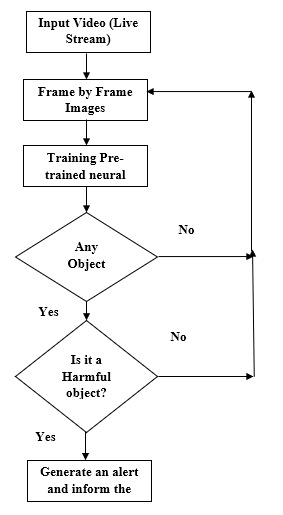Harmfull Object Detection
Objective
The main goal of this project is to detect multiple objectives with harmful objects to help blind people and also near object Refractive Error persons (eye problems) while walking or travelling on roads to avoid accidents that may even be caused by vehicles.
Abstract
Due to object detection’s close relationship with video analysis and image understanding, it has attracted much research attention in recent years. Traditional object detection methods are built on handcrafted features and shallow trainable architectures. Their performance easily stagnates by constructing complex ensembles which combine multiple low-level image features with high-level context from object detectors and scene classifiers. With the rapid development in deep learning, more powerful tools, which are able to learn semantic, high-level, deeper features, are introduced to address the problems existing in traditional architectures. These models behave differently in network architecture, training strategy and optimization function, etc. In this project, we provide a review on deep learning based harmful object detection frameworks. Our review begins with a brief introduction on the history of deep learning and its representative tool, namely Convolutional Neural Network (CNN). Then we focus on typical generic object detection architectures along with some modifications and useful tricks to improve detection performance further. Our experiments mainly focus on three kinds of dangerous objects: scissor, knife and guns etc.
Keywords: deep learning, object detection, CNN, harmful objects.
NOTE: Without the concern of our team, please don't submit to the college. This Abstract varies based on student requirements.
Block Diagram

Specifications
HARDWARE SPECIFICATIONS:
- Processor: I3/Intel
- Processor RAM: 4GB (min)
- Hard Disk: 128 GB
- Key Board: Standard Windows Keyboard
- Mouse: Two or Three Button Mouse
- Monitor: Any
SOFTWARE SPECIFICATIONS:
- Operating System: Windows 7+
- Server-side Script: Python 3.6+
- IDE: PyCharm
- Libraries Used: Pandas, Numpy, Flask.
Learning Outcomes
- Practical exposure to
- Hardware and software tools
- Solution providing for real time problems
- Working with team/individual
- Work on creative ideas
- Testing techniques
- Error correction mechanisms
- What type of technology versions is used?
- Working of Tensor Flow
- Implementation of Deep Learning techniques
- Working of CNN algorithm
- Working with OpenCV
- Building of model creations
- Scope of project
- Applications of the project
- About Python language
- About Deep Learning Frameworks
- Use of Data Science





 Paper Publishing
Paper Publishing
